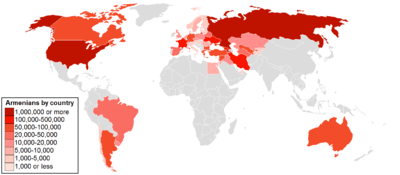Armenian-Dutch
| Total population | |
|---|---|
| 3,000[1] up to 9,000 | |
| Regions with significant populations | |
| Languages | |
| Armenian, Dutch As well as Persian, Russian, Turkish, and/or Arabic as second or third languages | |
| Religion | |
| Armenian Apostolic, Armenian Catholic, Evangelical and Protestant | |
| Related ethnic groups | |
| Armenian, Hamshenis, Cherkesogai groups |
| Part of a series on |
| Armenians |
|---|
| Armenian culture |
|
Architecture · Art Cuisine · Dance · Dress Literature · Music · History |
| By country or region |
|
Armenia · Nagorno-Karabakh Republic Armenian diaspora |
| Subgroups |
| Hamshenis · Cherkesogai · Armeno-Tats · Lom people · Hayhurum |
| Religion |
|
Armenian Apostolic · Armenian Catholic Evangelical · Brotherhood · |
| Languages and dialects |
| Armenian: Eastern · Western |
| Persecution |
|
Genocide · Hamidian massacres Adana massacre · Anti-Armenianism |
|
Armenia Portal |
Armenian-Dutch (Dutch: Armeense Nederlanders) are citizens of the Netherlands of Armenian ancestry. The number of Armenians in the country is unknown because the Dutch Immigration Office only offers data on country of origin.
History
Armenian and Dutch interactions are believed to have started in the 13th and 14th centuries, when Dutch merchants arrived in Cilicia and Armenian trading houses opened in the Low Countries. Armenians brought into the Low Countries carpets, dyes, cotton, and spices from Armenia and from around the world.
Apart from the contemporary Armenian community spread out over the Netherlands, there had been an independent Armenian community concentrated in Amsterdam during the 17th and 18th centuries.
Many Armenian merchants in Amsterdam went to Southeast Asia in the 19th century to trade, and to set up factories and plantations, establishing a community of Armenians in Java.
The Napoleonic wars put an end to the Armenian life in the Netherlands. The city of Amsterdam was almost depopulated after its occupation by the French. In 1713 the city of Amsterdam permitted the Armenians to erect a church of their own. After serving its purpose for about a century and a half, this edifice was closed because of the dwindling of its congregation. In 1874, by order of the Catholicos of Echmiadzin, the building was sold for 10,000 florins, which was transmitted to him.[2] It is probable that the Armenian community assimilated into the wider Dutch nation during the 19th century.
Armenians arrived in the Netherlands from Indonesia (the former Dutch Indies in the 1950s), Turkey (1970s), Lebanon (1970s), Iran (1980s), Iraq (early 1990s), Russia and Armenia (1990s).
Community
The largest group of Armenians arrived from Turkey (Diyarbakir and Şırnak) in the 1970s as guest workers in chain migration, finding employment in textile plants in Almelo and Hengelo. Currently most Armenians live in the major urban centres in the western part of the Netherlands: Amsterdam, Dordrecht, The Hague, Leiden and Rotterdam. Armenian church services are held in Amsterdam, Maastricht and Almelo.
Notable people
- Gago Aroetjunjan – kickboxer and Muay Thai fighter
- Sahak Parparyan, kickboxer and Muay Thai fighter
- Biurakn Hakhverdian – water polo player, olympic gold medalist and former captain of the Dutch national junior water polo team
- Karapet Karapetyan, kickboxer
- Gegard Mousasi, mixed martial artist
- Aras Özbiliz, football player playing for FC Spartak Moscow
See also
References
- ↑ ArmeniaDiaspora.com - ARMENIAN POPULATION IN THE WORLD
- ↑ Vahan M. Kurkjian. A History of Armenia, pp. 471
